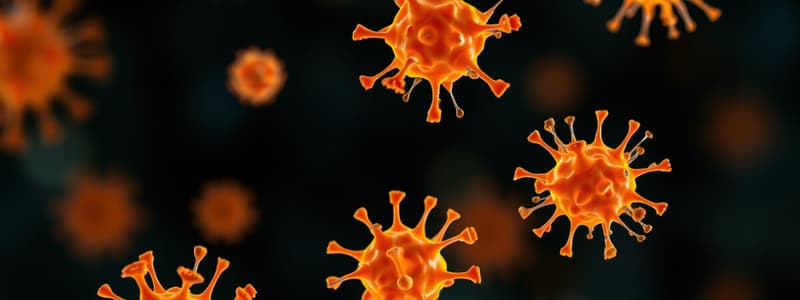Podcast
Questions and Answers
What is self-tolerance in the immune system?
What is self-tolerance in the immune system?
The process that prevents an active and specific immune response against self-antigens.
Which of the following is not a mechanism of tolerance?
Which of the following is not a mechanism of tolerance?
- Autoimmunity (correct)
- Negative selection
- Peripheral tolerance
- Central tolerance
What are the two levels at which tolerance is established?
What are the two levels at which tolerance is established?
Central tolerance and peripheral tolerance.
Where does central tolerance take place?
Where does central tolerance take place?
What happens to T cells that have a high affinity for self-antigens during negative selection?
What happens to T cells that have a high affinity for self-antigens during negative selection?
What is the function of regulatory T cells (Tregs)?
What is the function of regulatory T cells (Tregs)?
What role does the AIRE gene play in central tolerance?
What role does the AIRE gene play in central tolerance?
What is peripheral tolerance?
What is peripheral tolerance?
What are the three mechanisms for maintaining peripheral tolerance?
What are the three mechanisms for maintaining peripheral tolerance?
Flashcards are hidden until you start studying
Study Notes
Tolerance and Autoimmunity
- The immune system's primary function is distinguishing self from non-self antigens.
- Autoimmunity occurs when the immune system incorrectly targets self-antigens, resulting in autoimmune diseases.
- Self-tolerance mechanisms are crucial for preventing harmful immune responses against self-antigens.
Importance of Immunological Tolerance
- Antigen-specific binding sites in T and B cell receptors arise from random gene segment selection (V(D)J recombination).
- This randomness leads to the production of potentially harmful receptors that may attack self-tissues.
- Selection processes are necessary to eliminate autoreactive receptors.
Mechanisms of Tolerance
- Central Tolerance: Established before lymphocytes mature, occurring in primary lymphoid organs (thymus and bone marrow).
- Involves negative selection, where immature T cells with high affinity for self-antigens undergo apoptosis.
- Surviving cells mature and migrate throughout the immune system.
- CD4+ T cells can differentiate into regulatory T cells (Tregs) after exposure to self-antigens.
- Tregs play a key role in maintaining tolerance and express specific markers (CD4+, FoxP3+, CD25+).
- Development is reliant on interleukin-2 (IL-2) and the transcription factor FoxP3.
- Autoimmune regulator (AIRE) gene enables the expression of tissue-specific antigens in the thymus, crucial for negative selection.
- AIRE deficiency leads to autoimmune polyendocrinopathy candidiasis ectodermal dystrophy (APECED), manifesting as multiple autoimmune symptoms.
Peripheral Tolerance
- Occurs after lymphocyte maturation, operating as a secondary checkpoint in peripheral tissues.
- Prevents responses against harmless foreign antigens, such as dietary components.
- Involves mechanisms like Anergy, Suppression, and Deletion to maintain tolerance across the body.
Anergy
- A state where lymphocytes recognize self-antigens but fail to activate; serves as a protective mechanism against autoimmunity.
Studying That Suits You
Use AI to generate personalized quizzes and flashcards to suit your learning preferences.



